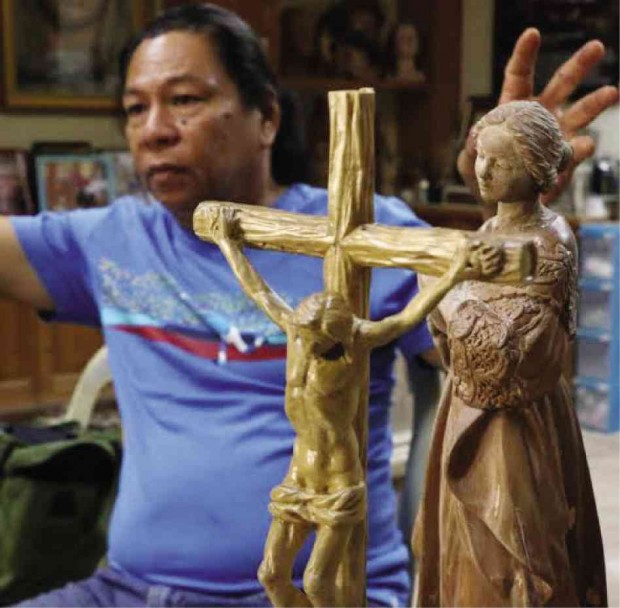Town that refuses to die has produced priests, woodcarvers

WILFREDO Layug, a sculptor from Betis in Guagua, Pampanga province, is a recipient of the Pro Ecclesia et Pontifice (For the Church and the Pope) medal and certificate, which are awarded by the Pope to lay persons. E.I. REYMOND T. OREJAS/CONTRIBUTOR
THE DEFUNCT town of Betis in Pampanga province, although annexed to Guagua 112 years ago, still thrives. It hosts a Sistine Chapel-like church that has been declared a national cultural treasure.
It has produced many priests, reared children early in Catholic faith through catechism and churned out religious arts and furniture carved from wood.
Add a new feat: Betis now has a papal awardee. And he’s a sculptor.
Wilfredo Layug received the Pro Ecclesia et Pontifice (For the Church and the Pope) medal, which the Pope gives to lay persons for their exemplary service to the church.
Lingayen-Dagupan Archbishop Socrates Villegas, president of the Catholic Bishops’ Conference of the Philippines, conferred the award and a certificate from Vatican City on March 8 at the Metropolitan Cathedral in the City of San Fernando in Pampanga.
Article continues after this advertisementLayug, 57, credits the award to his family and Betis, the milieu where this artist makes “retablo” (multilevel caverns of images of saints behind the major altar), altars, crucifixes, statues and other works.
Article continues after this advertisementSurprised
He was surprised to get the award because he considered himself basically a “santero” (maker of images of saints), like many woodcarvers in the seven villages of Betis.
Ecclesiastical artist was a recent description of him. The title stuck after the granting of the Presidential Medal of Merit from then President Gloria Macapagal-Arroyo, now congresswoman for Pampanga’s second district, which includes Guagua.
Trained by maestros in Seville, Spain, Layug introduced finer techniques such as gilding, gold leafing, “estofado” (a technique of “embroidery” on wood) and “polychromado” (painting the face of a religious figure).
He believed he was nominated for two sets of major works. These include the altar he made for the Pontificio Collegio Filippino in Rome in October 2012 and the seven pieces he crafted for the first visit of Pope Francis to the Philippines in January 2015.
The altar put together the first two Filipino saints, San Lorenzo Ruiz and San Pedro Calungsod. For Francis’ visit, Layug carved two Marian images (the first now known as the Our Lady of Hope of Palo, Leyte), a 10-foot tall crucifix, a lectern, two small crosses and a processional cross.
Major legacies
Layug’s latest achievement reflected what residents confirmed to researcher Nina L.B. Tomen as major legacies of Betis: the St. James the Apostle Church as a landmark of faith, its woodcraft industry, its priests and the Centro Catolico-culture that evolved and is expressed in rituals, traditions and daily life.
These facets are documented in the book “Suli (Legacies of Santiago Apostol Church of Betis)” by Tomen and Betis-born Bishop Pablo Virgilio David.
Published during the 440th anniversary of Christianity in Pampanga in 2012, the book traced the Muslim origin of Betis, how it took to Catholicism with intense devotion through the guidance of Augustinian friars and Filipino priests and how deep faith in God helped the folk survive the Mt. Pinatubo eruptions and lahar rampages that dragged for seven years.
Layug learned the Gospels through the paintings on the ceilings and wall of Betis church. At 5, he molded figures of saints from clay he gathered at the bank of a river. At 8, he sketched religious icons and furniture. He started woodcarving at 13 and got his first break at 17 by making a bas-relief of a replica of Santiago Matamoros at the gate of Fort Santiago.
The career of this Fine Arts graduate of University of Santo Tomas bloomed after he carved the altar of the Santo Domingo Church in Quezon City in 1987.
The papal award “brings honor to Betis,” said this son of a “mandaras” (boat maker). “It comes with bigger responsibilities,” he added, referring to the need to train more young people.